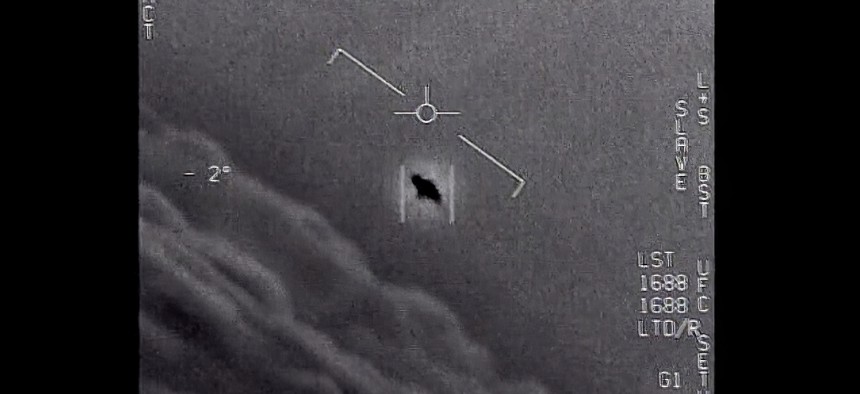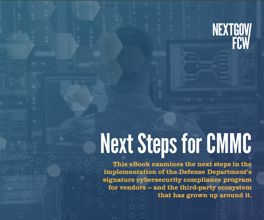Experts Assess the Unexplained in Government’s Recent UFO Report

The image from video provided by the Department of Defense labelled Gimbal, from 2015, an unexplained object is seen at center as it is tracked as it soars high along the clouds, traveling against the wind. Department of Defense via AP
Officials briefed Nextgov on notable inclusions—and what might come next.
U.S. sensors registered multiple incidents of unidentified aerial phenomena—the government’s fresh term for UFOs—but most remain unexplained due to limitations around data and collection capabilities, the unclassified version of a highly-anticipated intelligence report confirmed Friday.
In that 9-page preliminary assessment on the Pentagon’s UAP Task Force from the Office of the Director of National Intelligence, officials suggested extending research and development resources to explore existing unknowns. They also pointed to new ways government entities can use emerging technology to make more sense of those occurrences.
“Consistent consolidation of reports from across the federal government, standardized reporting, increased collection and analysis, and a streamlined process for screening all such reports against a broad range of relevant USG data will allow for a more sophisticated analysis of UAP that is likely to deepen our understanding,” they wrote. “Some of these steps are resource-intensive and would require additional investment.”
Current and former Pentagon officials, lawmakers and experts in this niche space are mixed in their views of the document. To some, it’s a confirmation of long-doubted occurrences, and to many, it ushers in a new era of openness for a formerly more taboo topic.
“This preliminary report marks an important first step: It affirms that UAP are real,” Luis Elizondo, a former intelligence officer who was involved in a previous Pentagon task force studying sky-based anomalies, told Nextgov Monday. “It also indicates that the task force could not identify any foreign nation as the source of these vehicles, nor are they the result of secret U.S. R&D programs.”
Exploring the Unknowns
From flying saucers to UAP, humans have long speculated about objects in the sky that appear to do things that transcend the capabilities of modern technology. The government has a deep, rocky history grappling with the area. But after mounting public pressure, the Pentagon last year released and confirmed the authenticity of three videos from the Navy depicting baffling, UFO-type phenomena. The Defense Department also announced its formation of a UAP Task Force to investigate those happenings.
Congress mandated ODNI to publish this unclassified report diving into the novel group’s progress via a provision buried into the more than $2 trillion coronavirus relief and appropriations bill signed by former President Donald Trump near the end of his tenure.
“Legend says there's about a 70- or 80-page classified version,” Tim McMillan, a former law enforcement officer who co-found and runs the media website The Debrief, told Nextgov Saturday.
McMillan had a unique police career before he entered this realm of UAP-investigating. He was a crime scene technician, K-9 handler, investigator, sergeant, intelligence and investigative analyst, and lieutenant and assistant patrol commander in Georgia, among other roles. But his personal experience seeing “something weird in the sky” years ago with another police sergeant—in a suburb not far from Navy-reported sightings, he noted—put him on a path to eventually study and produce a range of UFO-aligned analyses.
ODNI’s initial report provided more information than he thought it would.
“That might be an unpopular opinion because I think that some of the expectations that were out there from a lot of people were really lofty,” McMillan said. Many were generally hoping for definitive conclusions, he noted, around what was actually behind the incidents—whether non-Earthly aliens or adversaries.
“But I never really expected that because the hallmark of a good intelligence analysis report is the ability to say ‘we don't know,’ and I know that frustrates people,” he said. “Intelligence is not science.”
There’s likely more information in the classified report. That broader document was also delivered on Friday, a House Intelligence Committee official told Nextgov Monday. They declined to share details on its length or inclusions.
Still, the unclassified first assessment presents some hard numbers, as well as descriptions of obstacles and unknowns.
“Sociocultural stigmas and sensor limitations remain obstacles to collecting data on UAP,” intelligence and military officials wrote in the assessment. Further, “limited data and inconsistency in reporting are key challenges to evaluating UAP,” they explained.
One standardized reporting mechanism to report the spotted anomalies didn’t exist until the Navy established such a tool in March 2019. The Air Force adopted it in November 2020—but it remains limited, according to the report. Officials opted to zoom in on information from reports collected between 2004 and 2021 “that involved UAP largely witnessed firsthand by military aviators and that were collected from systems we considered to be reliable.”
Those encompassed 144 reports originating from government sources, and 80 of which involved observations with multiple sensors.
“It’s important to note that the unclassified version of the task force’s report is only a few preliminary pages,” Elizondo explained. “The videos, photos, and data which I and my colleagues in the Pentagon were privy to were not included.”
Most of the sightings disrupted military activities, officials noted in the assessment. And some of the instances were hazardous—including 11 that documented pilots reporting “near misses with a UAP.” The assessment’s makers also found that in “18 incidents, described in 21 reports, observers reported unusual UAP movement patterns or flight characteristics”—and in a number of those cases, aircraft also processed radio frequency, or RF, energy.
“We are conducting further analysis to determine if breakthrough technologies were demonstrated,” they wrote.
In his studies, McMillan has connected with many pilots who have witnessed airborne anomalies and incidents. “We should all kind of agree that, yeah—we need to take this seriously if we have aviators who are having to avoid near collision with these objects,” he said. “We need to check out what's going on here, even if it's just the rapid proliferation of commercial drones.”
UAP sightings often tended to “cluster” around U.S. training and testing grounds. However, this likely results from a collection bias, as most of the government’s latest generation sensors are mounted in such locations.
“It was pretty conclusive that immediate instances involve actual physical objects because they're being measured by multiple sensors,” McMillan explained. He said it’s highly intriguing that multiple sensors could back—but not explain—human sightings of happenings that seem to go beyond the bounds of American capabilities.
“The United States has the most robust measurement and signals intelligence collection apparatus in the world,” McMillan said. “And so, with that whole need for more R&D investments, which was kind of spot-on, they're saying, ‘We've got a great intelligence apparatus for monitoring China and Russia and all these other places—but whatever we're talking about here is something different.”
Those involved determined the origin of only one UAP with high confidence, deeming that object was a deflating balloon. Outside of that, researchers said they didn’t have adequate information to attribute incidents to explanations. Without one single reasoning for the incidents, the report lists five groups the UAP might fall into. They include airborne clutter, natural atmospheric phenomena, government or industry program, foreign adversary systems, and other.
“Out of the 144 military encounters studied, primarily in just the past two years, the task force was able to positively identify only one object, and they indicated that we may need a new understanding of science to identify many of the others. It’s now time to solicit help from the public and scientific community,” Elizondo said. “I’m confident that as we work together, we will begin uncovering extraordinary answers.”
‘Ignorance is Not Intelligence’
The task force plans to widen its scope and expand its collection to envelop more UAP-aligned events captured by other government personnel and systems going forward.
“As the dataset increases, the UAPTF’s ability to employ data analytics to detect trends will also improve,” officials wrote in the report. “The initial focus will be to employ artificial intelligence/machine learning algorithms to cluster and recognize similarities and patterns in features of the data points.”
Much of the data the task force has turned to is from the Navy, but it plans to acquire more from the Federal Aviation Administration. The group also intends to revamp its interagency information gathering strategy and explore new ways to grow its collection of UAP cluster areas, particularly in places where the forces aren’t present.
Experts agreed that it was high time for the government to begin standardizing relevant data and applying intelligent technology to the heaps of data that’s already been collected. China’s state media recently publicly announced that the nation has already implemented its own version of a UAPTF-type group in the last few years which, McMillan noted, employs AI in its efforts. Computer systems can parse through billions of data points in an exponentially rapid time compared to humans.
“There are so many very unique problems that AI can solve for us here,” McMillan said, adding that he wasn’t certain what the tech-based tools might look like, if they exist to date, or whether they’d come from the public or private sector.
Additional funding for research and development could further future studies across this realm, insiders noted among the report’s recommendations.
“I would anticipate much more from the Hill, and the Defense Department. Simply because again, as I said earlier, kind of the hallmarks of a good intelligence analysis report is the ability to say ‘we don't know.’ But at the same time,” McMillan said, “ignorance is not intelligent when you’re in the business of intelligence.”
The deputy defense secretary issued a memo to reaffirm and formalize the task force’s mission, seemingly moments after the report was released. Congressional leaders, particularly a few on the intelligence and armed services committees, also issued statements expressing that UAP encounters are becoming more frequent, a need for more resources—and that the report is “just the beginning.”
“We look forward to reviewing the report and will host a classified briefing for the members of the House Intelligence Committee later this year based on its findings and to build on the Member briefing held last week,” Rep. Adam Schiff, D-Calif., said. “As we continue to receive updates, we will share what we can with the American people as excessive secrecy will only spur more speculation.”
RELATED PODCAST



